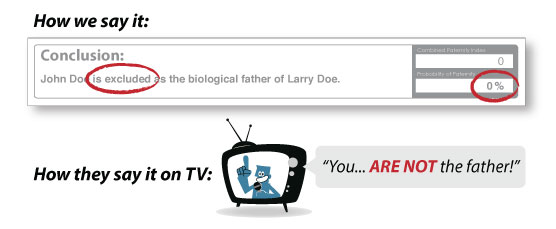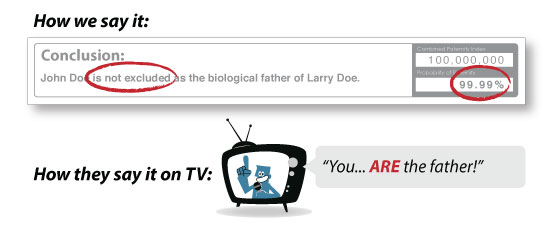A DNA paternity test compares a child's DNA pattern with that of an "alleged father" to determine if there is a match. When performed correctly in an experienced laboratory, it's the most definitive proof of a biological relationship.
What Do My Paternity Test Results Mean?
The precise language used in your paternity
report is very important but, because it’s also very technical, it can
sometimes be hard to understand. The report language is familiar to
scientists, lawyers, and judges. To help with understanding your
results, we’ve also shown you how they might say it on TV, instead of in
a courtroom.
Your Report
Each paternity test report shows the following information:
- Conclusion
- Combined Paternity Index (CPI)
- Probability of Paternity
- Data table of DNA markers (or genetic systems)
The Conclusion states whether the possible father is EXCLUDED or is NOT EXCLUDED
as the biological father (see explanations below). The data table lists
the different DNA markers (or “genetic systems”) examined by scientists
to create the CPI and Probability of Paternity.
Your Result
If the Conclusion reads, “is EXCLUDED as the biological father,” this means that he is NOT the father
because the data in the table do not support a paternity relationship.
When a possible father is EXCLUDED as the biological father, the
Combined Paternity Index (CPI) is 0 and the Probability of Paternity is
0%.

If the Conclusion reads, “is NOT EXCLUDED as the biological father,” this means that he is most likely to BE the father
because the data in the table strongly support a paternity
relationship. When a possible father is NOT EXCLUDED, the Combined
Paternity Index (CPI) is 100 (or larger) and the Probability of
Paternity is typically 99.99% (or higher).

Why do TV personalities say “you are the father” while scientists say you are “not excluded as the biological father”?
Scientists use precise language, whereas TV
personalities generalize for dramatic effect. DNA paternity testing uses
powerful statistics to create a probability of paternity, and the
highest probability possible is 99.99% (not 100%). Saying, “You ARE the
father,” implies a 100% probability of paternity, which is technically
incorrect.
So, just how powerful is a 99.99% probability of paternity?
A 99.99% probability of paternity is so
powerful, that it’s routinely accepted as evidence in favor of paternity
by genetic scientists, courtroom judges, and even the U.S. State
Department. Although the scientific language is more technical than how
they say it on TV, the bottom line is the same: a DNA paternity test
probability of 99.99% is strong enough for a judge to confidently allow
(or deny) child support, immigration, or even conviction in a criminal
case. It’s also why a TV host feels confident enough to say, “You ARE
the father.”
https://dnatesting.com/what-do-my-results-mean/

Diagnostics & Testing
DNA Paternity Test
What is paternity testing?
Paternity testing can determine whether or not a particular man is the biological father of a child. This procedure involves collecting and examining the DNA of a small sample of bodily fluid or tissue from a child and the potential father. DNA is the unique genetic "fingerprint" that makes up a person’s genes and chromosomes. When a baby is conceived, each parent passes on half of his/her DNA to the baby, whose genetic code (DNA) is a shared mix of only its mother’s and father’s DNA. By collecting and examining a small sample of DNA from the baby and the potential father, a paternity test can confirm or disprove that the potential father is indeed the biological father of the baby.What bodily fluids and tissues can be sampled?
DNA is present in most of our body’s cells. A small sample for testing can be obtained from several bodily sources. The cells most commonly tested are obtained from the blood or inside the cheek of the mouth (called buccal cells).How is the cheek cell test conducted?
Cells are collected by gently rubbing a cotton swab – similar to a Q-tip® - on the inside cheek of the mouth. The swab is sent to a laboratory and a select number of specific DNA sequences are examined to determine if the DNA collected from the baby match DNA collected from the alleged father.How accurate is DNA testing?
DNA testing is generally considered to be the most accurate testing method available. DNA paternity testing can indicate that a man is highly likely to be the father with about 99.9% accuracy or that he is excluded as being the father with 100% accuracy.Can paternity be confirmed before the baby is born?
Technically, yes. Two different tests can be done while the baby is still developing in the mother’s womb. One test, called chorionic villus sampling (CVS), is conducted only between 11 to 13 weeks of pregnancy. This test involves testing a small sample of tissue from the placenta. Another test, called amniocentesis, is usually performed between 16 and 22 weeks of pregnancy. This test involves passing a needle through the mother’s abdomen into the womb to collect a small sample of amniotic fluid (the “water” around the baby), which also contains cells from the baby. The collected samples are then forwarded to a laboratory for examination. Although technically possible to confirm paternity with these tests, the risk of miscarriage – generally given as 1% (1 in 100) for CVS and 0.5% (1 in 200) for amniocentesis leads most physicians not to offer CVS or amniocentesis only for paternity testing. People who have questions about this should speak with their physicians.How long does it take to obtain test results?
Results of buccal cell DNA paternity testing are usually available within 5 to 10 days after receipt by the laboratory. DNA paternity testing by CVS or amniocentesis would take between three and four weeks before results could be made available.Are home DNA paternity testing kits available?
Yes. Several laboratories offer home testing kits that can be purchased over the Internet. The kits contain all the necessary materials and instructions for conducting a cheek cell swab test. After the DNA cheek cells are collected, the sample is sent to the laboratory for analysis. If directions are correctly followed, the testing technique and accuracy of a privately conducted home test does not differ compared with a test required by court order. For court ordered testing, however, the potential father would need to report to a designated paternity testing facility so that the testing can be witnessed and fingerprints and photographs can be confirmed.How can I locate a paternity testing facility?
The AABB (formerly known as the American Association of Blood Banks) is an organization that provides accreditation for laboratories offering relationship testing (including paternity testing). Accreditation means that each laboratory listed has met specific standards for testing accuracy and service. For a list of AABB accredited relationship testing facilities, please visit AABB Accredited Relationship Testing Facilities.Can the results of a home test be used in a court of law?
Without legal identification of the test taker and official witnessing of the test, a home paternity test is not admissible in court.How much does a paternity test cost?
Tests costs will vary from less than $100 for some home kits to over $500 for the complete testing process through an accredited facility. Prenatal paternity testing is usually much more expensive because of the ultrasound, CVS or amniocentesis procedure, and doctor fees, You will need to contact your nearest facility to get an exact price estimate.References
- U.S. National Library of Medicine. Chromosomes. Accessed 8/23/2013.
- National Human Genome Research Institute. Deoxyribonucleic Acid (DNA). Accessed 8/23/2013.
- American Pregnancy Association. Paternity Testing. Accessed 8/23/2013.
Can you get a paternity test while the baby is still in the womb?
Technically, yes. Two different tests can be done while the baby is still developing in the mother's womb. One test, called chorionic villus sampling (CVS), is conducted only between 11 to 13 weeks of pregnancy. This test involves testing a small sample of tissue from the placenta.
Thanks for shearing about this I thinks its very hopeful post and very important post for us. Thanks for your great and helpful presentation I like your good service.I always appreciate your post. Excellent information on your blog, thank you for taking the time to share with us.
ReplyDeletegenetic swab test